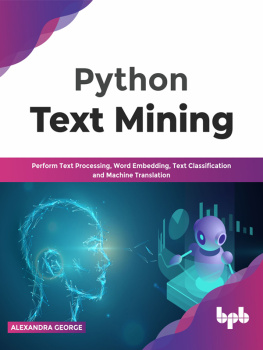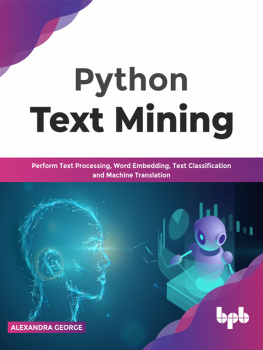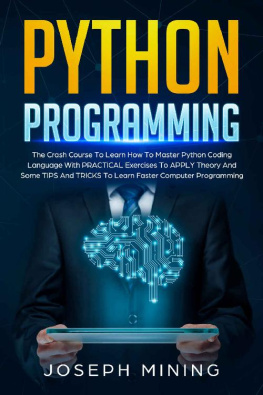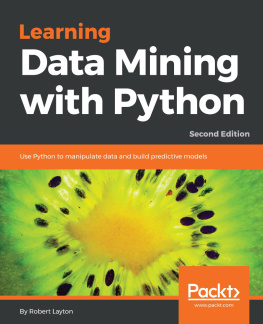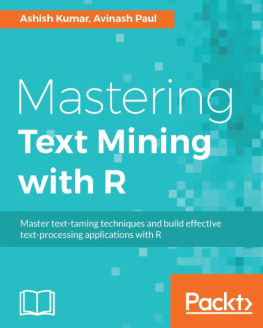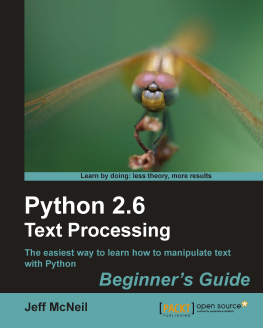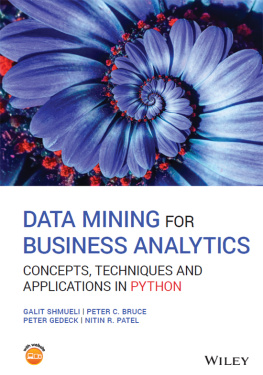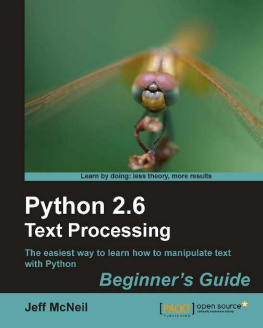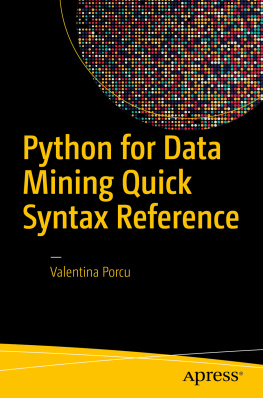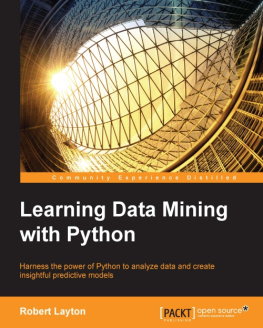George Alexandra - Python Text Mining
Here you can read online George Alexandra - Python Text Mining full text of the book (entire story) in english for free. Download pdf and epub, get meaning, cover and reviews about this ebook. year: 2022, publisher: BPB Publications, genre: Home and family. Description of the work, (preface) as well as reviews are available. Best literature library LitArk.com created for fans of good reading and offers a wide selection of genres:
Romance novel
Science fiction
Adventure
Detective
Science
History
Home and family
Prose
Art
Politics
Computer
Non-fiction
Religion
Business
Children
Humor
Choose a favorite category and find really read worthwhile books. Enjoy immersion in the world of imagination, feel the emotions of the characters or learn something new for yourself, make an fascinating discovery.
- Book:Python Text Mining
- Author:
- Publisher:BPB Publications
- Genre:
- Year:2022
- Rating:5 / 5
- Favourites:Add to favourites
- Your mark:
- 100
- 1
- 2
- 3
- 4
- 5
Python Text Mining: summary, description and annotation
We offer to read an annotation, description, summary or preface (depends on what the author of the book "Python Text Mining" wrote himself). If you haven't found the necessary information about the book — write in the comments, we will try to find it.
Python Text Mining — read online for free the complete book (whole text) full work
Below is the text of the book, divided by pages. System saving the place of the last page read, allows you to conveniently read the book "Python Text Mining" online for free, without having to search again every time where you left off. Put a bookmark, and you can go to the page where you finished reading at any time.
Font size:
Interval:
Bookmark:

Text Mining

Text Classification and Machine Translation

 www.bpbonline.com FIRST EDITION 2022Copyright BPB Publications, IndiaISBN: 978-93-89898-781 All Rights Reserved. No part of this publication may be reproduced, distributed or transmitted in any form or by any means or stored in a database or retrieval system, without the prior written permission of the publisher with the exception to the program listings which may be entered, stored and executed in a computer system, but they can not be reproduced by the means of publication, photocopy, recording, or by any electronic and mechanical means. LIMITS OF LIABILITY AND DISCLAIMER OF WARRANTY The information contained in this book is true to correct and the best of authors and publishers knowledge. The author has made every effort to ensure the accuracy of these publications, but publisher cannot be held responsible for any loss or damage arising from any information in this book. All trademarks referred to in the book are acknowledged as properties of their respective owners but BPB Publications cannot guarantee the accuracy of this information.
www.bpbonline.com FIRST EDITION 2022Copyright BPB Publications, IndiaISBN: 978-93-89898-781 All Rights Reserved. No part of this publication may be reproduced, distributed or transmitted in any form or by any means or stored in a database or retrieval system, without the prior written permission of the publisher with the exception to the program listings which may be entered, stored and executed in a computer system, but they can not be reproduced by the means of publication, photocopy, recording, or by any electronic and mechanical means. LIMITS OF LIABILITY AND DISCLAIMER OF WARRANTY The information contained in this book is true to correct and the best of authors and publishers knowledge. The author has made every effort to ensure the accuracy of these publications, but publisher cannot be held responsible for any loss or damage arising from any information in this book. All trademarks referred to in the book are acknowledged as properties of their respective owners but BPB Publications cannot guarantee the accuracy of this information.  www.bpbonline.com
www.bpbonline.com He is an engineer, and high-tech who primarily works on data science, analytics, application development, and building intelligent systems. Alexandra research focuses on data mining, text mining as well as Machine Learning and Deep Learning applications.
First and foremost, I would like to thank my parents for continuously encouraging me to write the book. I could have never completed this book without their support. My gratitude also goes to the team at BPB Publications for being supportive enough to provide me quite a long time to finish the book and also giving us the opportunity and providing us the necessary support in writing this book. We would like to thank our family members for the support they have provided for us to focus on the book during our personal time.
Firstly, it shows how the text data can be preprocessed. It then moves on to solve the real time industry problems associated with the text data like context understanding or Machine Translation, and so on. This book gives information about the usefulness of Python in Natural Language Processing. This book takes a practical approach through the projects for NLP. It covers a few real-time industry examples as well. It covers information that Python basically used for text preprocessing and Natural Language Processing, which can also be used for easy data manipulating and transforming.
You can code different Natural Language Processing tasks by using the code and a bit of theory provided in this book as a blueprint, and use the same to solve the complex Natural Language Processing tasks. This book is divided into 10 chapters. They will cover the basics of preprocessing, converting texts to numbers, and model building in Natural Language Processing all this using a project, so that we can have a deep business understanding as well as the technical understanding of the method. The details are listed in the following section. Pre-processing in text data is done to convert the text into a predictable model and an analyzable format. As data scientists, we spend 95% of our time processing the data and only 5% of the time building the model.
The limit of pre-processing is subject to ones imagination; the basic pre-processing that is mandatory will be discussed in this chapter. Although there are various methods that perform the steps stated in this lesson, we will be looking at a set of libraries and programs for NLP in Python NLTK (Natural Language Toolkit) and a set of libraries and codes called the Regular expressions. The machine learning models cannot understand the text or special characters. It can only understand the numbers. Just like our computer, which uses the compiler and interpreter to convert the data from high-level language to machine language, we will need to convert all the text into numbers to make use of the data for the prediction and analysis purposes. This conversion of data from text to number or vectors (fancy term for calling the converted word as numbers) is mandatory as the model (both machine learning and deep learning) cannot understand anything other than numbers.
These word embeddings are nothing but word vectors, i.e., the vector representation of a word. It is one of the most popular representations of the vocabulary of the document. The advantage of using the word embedding is that it can capture the semantic and syntactical structure and other words related to this and so on. The word embeddings make use of the various methods that we will be reading in . Data mining is one of the important tasks of data analytics. Data mining is all about extracting information from the data.
With the increasing number of unstructured data, it is becoming harder for the data scientists to extract information. But thanks to technology, we have the capability to handle them. Topic modeling is one of the data mining techniques; the difference between using the regular expressions and rule-based is that topic modeling is an unsupervised technique that is used to extract a set of topics from the text. They can be used to organize a large amount of data. Text, in general, contains polarity, positive, negative, or neutral. This polarity extraction is known as the sentiment classification.
It is usually done in the sentence level. Sentiment classification finds its application in various places like opinion summarization, market analysis, identifying the voice of customers, and so on. Unsupervised Sentiment classification is done when the text does not contain sentiment labels. The input to the algorithm will be unlabeled data in this case to find the hidden polarities. We will be using unsupervised classification if the data does not contain sentiment labels. But if the data contains the sentiment labels, all we must do is build a model that trains on the pre-processed sentence-level sentiment labeled data, and thereby identifies the patterns that contribute to polarity and uses these patterns to predict the sentiment labels on the test data.
Font size:
Interval:
Bookmark:
Similar books «Python Text Mining»
Look at similar books to Python Text Mining. We have selected literature similar in name and meaning in the hope of providing readers with more options to find new, interesting, not yet read works.
Discussion, reviews of the book Python Text Mining and just readers' own opinions. Leave your comments, write what you think about the work, its meaning or the main characters. Specify what exactly you liked and what you didn't like, and why you think so.

